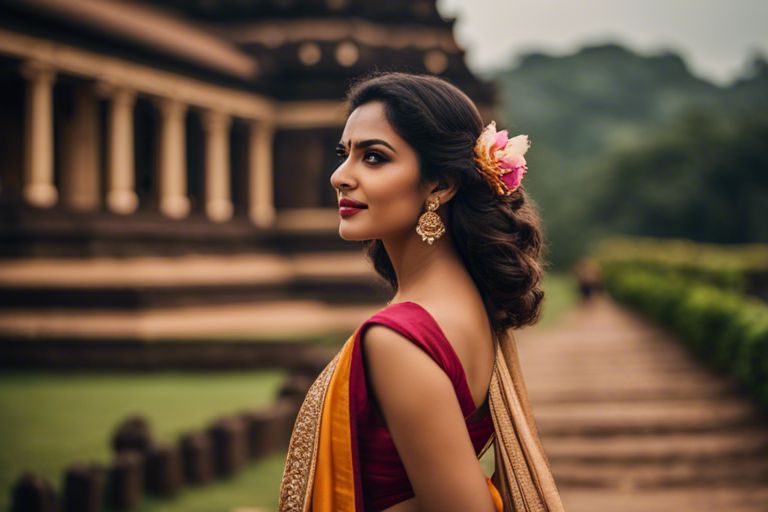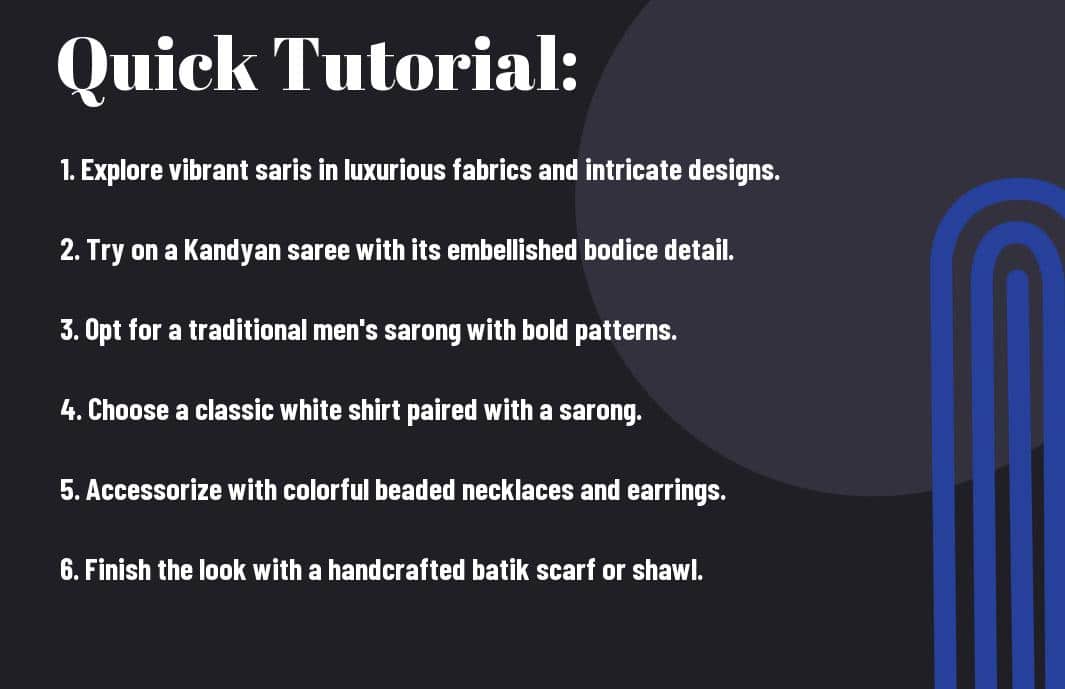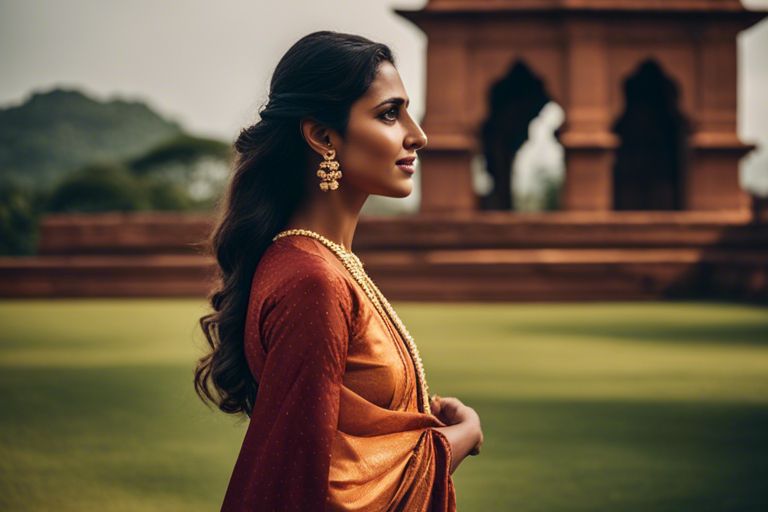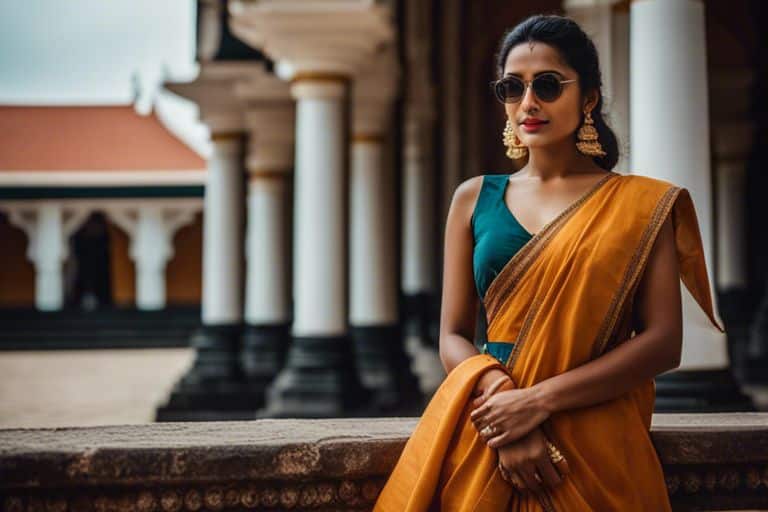Prepare to immerse yourself in the world of Sri Lankan fashion with our curated list of elegant traditional attire. Sri Lanka boasts a rich cultural heritage that is beautifully reflected in its traditional clothing. From vibrant saris to elaborate sarongs, each garment tells a story and holds a timeless appeal. If you’re looking to add a touch of Sri Lankan charm to your wardrobe, look no further than these must-have pieces.
Whether you’re attending a wedding, festival, or simply want to exude sophistication in your daily wear, these exquisite traditional outfits are sure to make a statement. Our top 10 list features garments that are not only stylish but also deeply rooted in Sri Lankan culture. From the intricate detailing of Kandyan sarees to the bold colors of Osariya, each piece captures the essence of elegance and tradition.
For a closer look at these stunning Sri Lankan traditional clothes, check out our Beautiful Sri Lankan Traditional Dresses for Every Occasion Pinterest board. Whether you’re a fashion enthusiast or simply appreciate the beauty of cultural attire, these garments are a must-have for anyone looking to add a touch of Sri Lankan grace to their wardrobe.
Key Takeaways:
- Sri Lankan Saree: A beautifully handcrafted attire made from luxurious fabrics like silk or cotton, adorned with intricate designs and vibrant colors.
- Osariya: A traditional saree worn with a jacket or shawl, perfect for formal occasions and cultural events.
- Batik Saree: A unique saree with batik designs, creating a stunning and contemporary look for modern Sri Lankan women.
- Traditional Kurtha: A stylish top that can be paired with a saree, a sarong, or even a pair of trousers, offering a versatile clothing option.
- Sarong: A versatile piece of cloth worn by both men and women, perfect for casual wear or special occasions.
- Handloom Saree: A saree made from handwoven fabric, showcasing the artistry and craftsmanship of Sri Lankan weavers.
- Lungi: A comfortable and stylish garment worn by Sri Lankan men, often paired with a casual shirt for a relaxed look.
Kandyan Saree
Regal attire
To truly embrace the essence of traditional Sri Lankan clothing, one must adorn the elegant Kandyan Saree. This regal attire is a symbol of grace and sophistication, often worn by women during formal occasions such as weddings, cultural festivals, and ceremonies. The Kandyan Saree exudes an aura of timeless beauty and tradition, making it a must-have in every Sri Lankan woman’s wardrobe.
Assuming a Kandyan Saree is like stepping into a world of royalty and elegance. The attire typically consists of a blouse, a long skirt, and a wrap-around cloth that is draped over the shoulder. The intricate details and vibrant colors of the fabric reflect the rich cultural heritage of Sri Lanka, making the Kandyan Saree a true masterpiece of traditional attire.
Distinct draping
With its distinct draping style, the Kandyan Saree sets itself apart from other traditional clothing. The intricate pleating and folding of the fabric create a fluid and graceful silhouette that enhances the wearer’s beauty and poise. The saree is often embellished with intricate embroidery, beading, or lacework, adding an extra touch of glamour to the ensemble.
To master the art of draping a Kandyan Saree is to embody the essence of traditional Sri Lankan fashion. The way the fabric cascades elegantly around the body, highlighting the curves and movements of the wearer, is truly mesmerizing. It is a testament to the craftsmanship and artistry of the traditional weavers and designers who have passed down their skills through generations.
Osariya
While Cultural Fusion: Breaking Down The 10 Most Popular Clothing Brands in Sri Lanka has influenced modern fashion trends, traditional Sri Lankan clothing continues to hold a special place in the hearts of the people. One such attire that symbolizes elegance and grace is the Osariya. The Osariya, also known as the Kandyan saree, is a traditional form of dress worn by women in Sri Lanka, especially for formal occasions like weddings and cultural ceremonies.
Traditional Kandyan
Traditional Kandyan women’s clothing is rich in history and cultural significance. The Osariya consists of a blouse, a draped saree, and an intricate belt known as the “Udarata Mul Anduma.” The saree is draped in a unique style with pleats at the front and the loose end draped over the shoulder. The elaborate embroidery and patterns on the saree and blouse reflect the craftsmanship and artistry of Sri Lankan artisans.
The Traditional Kandyan Osariya is a symbol of elegance and sophistication, with its vibrant colors and luxurious fabrics. The attire is often accessorized with traditional jewelry like the “Hath-Patha” (seven chains), bangles, and hair ornaments, adding to the overall regal look. The meticulous attention to detail in the design and construction of the Osariya makes it a timeless piece of traditional Sri Lankan fashion.
Today, the Osariya is not only worn for formal events but has also found its way into modern fashion, with designers incorporating elements of the traditional attire into contemporary clothing lines. The fusion of traditional craftsmanship with modern designs has created a unique style that pays homage to Sri Lanka’s rich cultural heritage.
Women’s formal dress
The Osariya is the epitome of women’s formal dress in Sri Lanka, embodying grace and poise. Women wear the Osariya not just as a garment but as a symbol of tradition, culture, and pride. The careful draping of the saree and the intricate details of the blouse showcase the artistry and skill of Sri Lankan weavers and artisans. The Osariya is a cultural treasure that transcends generations, passed down from mothers to daughters as a cherished heirloom.
Plus, the Osariya is versatile in its styling, allowing women to experiment with different colors, fabrics, and embellishments to create a personalized look. Whether worn for a wedding or a cultural festival, the Osariya exudes timeless elegance and beauty. The attire’s significance goes beyond its aesthetic appeal, representing the essence of Sri Lankan culture and tradition. The Osariya truly captures the essence of Sri Lankan identity and showcases the country’s unique heritage through its intricate design and craftsmanship.
Cheeththa
Printed cotton fabric
Your exploration of traditional Sri Lankan clothing is incomplete without experiencing the beauty of Cheeththa, a popular printed cotton fabric. Known for its vibrant colors and intricate patterns, Cheeththa fabric is a staple in Sri Lankan fashion, adorning both men and women in a variety of styles. The lightweight and breathable nature of the fabric make it perfect for the tropical climate of Sri Lanka, keeping the wearer cool and comfortable in the heat.
Whether you opt for a Cheeththa saree or a Cheeththa shirt, you are sure to make a stylish statement with this timeless fabric. The versatility of Cheeththa allows you to dress it up for special occasions or dress it down for a more casual look, making it a must-have in your traditional clothing collection.
Embrace the cultural richness of Sri Lanka by incorporating Cheeththa into your wardrobe. The vibrant hues and intricate designs of this printed cotton fabric will not only add a touch of elegance to your attire but also showcase your appreciation for the heritage and tradition of this beautiful island.
Casual wear
An necessary component of Sri Lankan traditional clothing, casual wear made from Cheeththa fabric is a comfortable and stylish choice for everyday wear. Perfect for lounging at home or running errands in town, Cheeththa casual wear combines the convenience of modern fashion with the time-honored designs of Sri Lankan culture.
Adorned with bold prints and vibrant colors, Cheeththa casual wear stands out as a unique and eye-catching option for those who appreciate traditional clothing with a modern twist. Pair a Cheeththa top with your favorite jeans or skirts for a chic yet casual look that exudes both style and cultural pride.
Investing in Cheeththa casual wear is not just adding to your wardrobe; it is a way of embracing the heritage of Sri Lanka and supporting local artisans who have perfected the craft of creating these beautiful garments. Make a fashion statement that goes beyond aesthetics and signifies a deep respect for tradition and culture.
Sarong
Men’s Cloth Wrap
Once again, the sarong emerges as a versatile and timeless traditional garment in Sri Lanka. Men have embraced this elegant piece of clothing for generations, showcasing a sense of sophistication and style. The sarong for men is a long piece of fabric wrapped around the waist and tied securely, creating a comfortable and stylish look. It can be paired with a classic white shirt or a colorful batik shirt for a traditional and formal appearance.
Simple and Practical
With its simple yet practical design, the sarong is a staple in Sri Lankan traditional attire. Some may view it as just a piece of fabric, but the sarong holds cultural significance and is worn with pride by both men and women. The ease of wearing a sarong makes it a popular choice for everyday wear, as well as special occasions such as weddings and religious ceremonies.
Some may underestimate the importance of the sarong, but its versatility and comfort make it a must-have in every Sri Lankan’s wardrobe. The sarong can be worn in different styles, whether folded neatly for a formal look or draped loosely for a casual vibe. Its simplicity is what makes it stand out, showcasing the beauty of Sri Lankan traditional clothing.
The sarong exemplifies the essence of Sri Lankan culture and tradition, embodying elegance and grace. Its significance goes beyond just a piece of clothing, representing a connection to the rich heritage of the island. Embracing the sarong is not just about wearing a garment; it is about embracing a piece of history and culture that has stood the test of time.
Redda & Hatte
Rural Women’s Wear
Keep up with the traditional Sri Lankan charm by embracing the Redda and Hatte ensemble worn by rural women. The Redda is a long piece of cloth wrapped around the lower body, resembling a skirt, while the Hatte is a blouse that is worn on the upper body. This outfit exudes simplicity and elegance, making it a popular choice among women in rural areas.
Redda and Hatte are usually made from lightweight and breathable fabrics like cotton or linen, making them perfect for the hot and humid climate of Sri Lanka. The vibrant colors and intricate designs of these garments showcase the rich cultural heritage of the island, adding a touch of sophistication to any woman’s wardrobe.
Traditionally worn for everyday activities and special occasions, the Redda and Hatte embody the grace and beauty of Sri Lankan women. The versatility of this outfit allows women to move comfortably while still looking effortlessly stylish.
Two-piece Clothing
With roots in Sri Lankan history, two-piece clothing like the Redda and Hatte has stood the test of time and remains a staple in many women’s wardrobes. This traditional attire consists of the Redda, a wrap-around skirt, and the Hatte, a blouse worn on the upper body.
Two-piece clothing like the Redda and Hatte offers a blend of comfort and style, making it a popular choice for women of all ages. The Redda can be styled in different ways to suit various occasions, from casual gatherings to formal events. Paired with delicate jewelry and embellishments, this ensemble exudes an air of sophistication and elegance.
Women across Sri Lanka continue to embrace the Redda and Hatte, keeping the tradition alive while adding their own modern flair to the classic look. This two-piece outfit symbolizes the timeless beauty and cultural significance of Sri Lankan traditional clothing.
Nilame Attire
Many traditional Sri Lankan outfits are steeped in rich history and cultural significance. One such attire that holds a special place in Sri Lankan ceremonies is the Nilame attire. This traditional dress is often worn by individuals of high social standing, such as nobles or officials, during formal occasions and ceremonies.
Groom’s wedding dress
Nilame attire for the groom’s wedding dress is a sight to behold. The groom is adorned in a regal costume that exudes elegance and sophistication. The attire typically includes a richly embroidered jacket, intricately designed sarong, ornate headgear, and elaborate accessories. Each piece is carefully crafted with attention to detail, symbolizing the groom’s social status and importance.
The colors and designs of the Nilame attire for the groom are carefully chosen to represent cultural symbolism and heritage. Often, motifs inspired by nature, mythology, and ancient traditions are intricately woven into the fabric, making the attire a visual masterpiece. The groom’s wedding attire is not just clothing; it is a symbol of honor, prestige, and tradition that has been passed down through generations.
Ornate and historical
If you examine deeper into the history of Nilame attire, you will uncover a treasure trove of ornate designs and historical significance. Each element of the attire, from the intricate patterns to the choice of fabrics, reflects centuries-old traditions and customs. The craftsmanship involved in creating Nilame attire is a true testament to the skill and artistry of Sri Lankan artisans.
You can witness the fusion of different cultural influences in Nilame attire, from traditional Sri Lankan aesthetics to colonial-era embellishments. The attire not only showcases the opulence of Sri Lankan fashion but also serves as a reminder of the country’s rich heritage and cultural diversity. Wearing Nilame attire is not just about dressing up; it is a way of honoring traditions and preserving the legacy of the past.
Batik Wear
Wax-resist dyeing
After centuries of refinement, batik has become a well-loved art form in Sri Lanka. The process of wax-resist dyeing involves applying wax to fabric before dyeing it, creating intricate and beautiful patterns. This technique requires skill and precision, as the wax acts as a barrier, preventing certain areas of the fabric from absorbing the dye. The result is a unique design that showcases the artistry and craftsmanship of the creator.
Unique patterns
To add a touch of elegance to your wardrobe, consider incorporating batik wear into your collection. One of the standout features of batik clothing is the unique patterns that adorn each piece. From floral motifs to geometric shapes, these designs are rich in symbolism and cultural significance. Each pattern tells a story and adds depth to the garment, making it more than just a piece of clothing.
An crucial part of Sri Lankan traditional clothing, batik wear is a reflection of the island’s vibrant culture and heritage. The intricate patterns and bold colors of batik clothing are a visual feast for the eyes, capturing the essence of Sri Lanka’s artistry. Whether worn for a special occasion or as part of everyday attire, batik clothing adds a touch of sophistication and elegance to any wardrobe.
The art of batik wear is not just about fashion; it is a celebration of tradition and craftsmanship. Each piece is a labor of love, meticulously crafted by skilled artisans who take pride in their work. By embracing batik clothing, you are not just wearing a garment – you are carrying a piece of Sri Lankan culture with you, honoring the history and heritage of this beautiful island.
Beeralu Lace
Handmade lacework
Despite modern advancements in technology, handmade lacework continues to hold a special place in Sri Lankan traditional clothing. This intricate art form, known as Beeralu lace, has been passed down through generations, with skilled artisans meticulously creating beautiful lace designs using a wooden bobbin and thread.
There’s a certain elegance and charm that comes with handcrafted lacework, where each piece is carefully crafted with attention to detail. The process requires patience and precision, making it a time-consuming yet rewarding endeavor. The end result is a masterpiece of delicate lace that adds a touch of sophistication to traditional Sri Lankan attire.
Handmade lacework showcases the dedication and expertise of the artisans who have honed their skills over years of practice. The intricate patterns and designs reflect the rich cultural heritage of Sri Lanka, making Beeralu lace a prized possession for those who appreciate the beauty of traditional craftsmanship.
Delicate designs
On the intricate Beeralu lacework, you’ll find delicate floral motifs and geometric patterns that adorn traditional Sri Lankan garments. These designs add a touch of elegance and intricacy to the clothing, enhancing its beauty and cultural significance.
Handmade lacework requires a high level of skill and precision, as artisans carefully weave intricate patterns by hand. Each piece of lace is a work of art, showcasing the artisan’s creativity and attention to detail. The delicate designs of Beeralu lace have stood the test of time, remaining a timeless and cherished tradition in Sri Lankan fashion.
Handmade lacework not only adds a touch of sophistication to traditional clothing but also serves as a reminder of the artistry and craftsmanship of Sri Lankan artisans. The intricate designs of Beeralu lace continue to captivate fashion enthusiasts around the world, highlighting the beauty and cultural significance of this traditional craft.
Jumper and Jacket
Colonial influence
For centuries, Sri Lanka has been influenced by various colonial powers, which is evident in the country’s traditional clothing. The jumper and jacket ensemble is a perfect example of this colonial influence. Introduced during the British colonial period, these garments became staples in the Sri Lankan wardrobe. The jumper, typically made of fine wool or cotton, provides warmth while the jacket adds a touch of sophistication to the overall look.
Influenced by the British colonial style, the jumper and jacket ensemble has seamlessly integrated into Sri Lankan fashion, offering a blend of comfort and elegance like no other traditional attire. The colonial influence can be seen in the tailored fit of these garments, reflecting a fusion of Western and Sri Lankan tailoring techniques.
Tailored fit
There’s a distinct charm in the tailored fit of the jumper and jacket ensemble. The snug fit of the jumper complements the structured silhouette of the jacket, creating a polished and refined look. The tailored fit not only enhances the wearer’s physique but also exudes a sense of sophistication and class.
Embracing the tailored fit of the jumper and jacket ensemble allows individuals to showcase their sartorial elegance and style sensibilities. Whether worn for formal occasions or cultural celebrations, these garments never fail to make a lasting impression.
Final Words
Considering all points, it is evident that Sri Lankan traditional clothing is not only a reflection of the country’s rich cultural heritage but also a symbol of elegance and sophistication. The 10 must-have Sri Lankan traditional clothes highlighted in this article showcase the diversity and artistry of the country’s traditional attire, from the vibrant sarees to the regal sarongs. By embracing these traditional garments, individuals can not only celebrate the unique traditions of Sri Lanka but also make a stylish statement that is both timeless and elegant.
Whether it’s for a special occasion or simply to add a touch of luxury to everyday attire, Sri Lankan traditional clothing offers a plethora of options for fashion enthusiasts looking to exude grace and charm. From intricately embroidered blouses to intricately woven handloom skirts, each garment is a work of art that embodies the skill and craftsmanship of Sri Lankan artisans. By incorporating these must-have traditional pieces into their wardrobe, individuals can elevate their style with a touch of exoticism and cultural significance.
Overall, the 10 must-have Sri Lankan traditional clothes featured in this article serve as a guide for those looking to explore the beauty and elegance of Sri Lankan fashion. By understanding the significance of each garment and embracing the artistry and craftsmanship behind them, individuals can not only enhance their personal style but also pay homage to a culture steeped in tradition and heritage. Embrace elegance with Sri Lankan traditional clothing and make a fashion statement that is as sophisticated as it is timeless.
FAQ
Q: What is the significance of traditional Sri Lankan clothing?
A: Traditional Sri Lankan clothing is a reflection of the country’s rich cultural heritage and diversity. It plays a significant role in preserving and showcasing the beauty of Sri Lankan traditions.
Q: What are the 10 must-have Sri Lankan traditional clothes?
A: The 10 must-have Sri Lankan traditional clothes are saree, sarong, cheeththaya, osariya, kurakkan sataka, kandyan saree, redda and hatta, jacket, angampora costume, and ves costume.
Q: How is a saree worn in Sri Lankan tradition?
A: A saree is traditionally worn by wrapping the long cloth around the waist and draping it over the shoulder, showcasing elegance and grace in the wearer’s movement.
Q: What is the significance of sarong in Sri Lankan culture?
A: Sarong is a versatile piece of clothing that is worn by both men and women in Sri Lanka. It symbolizes comfort, simplicity, and cultural identity.
Q: What is the cheeththaya in Sri Lankan traditional clothing?
A: Cheeththaya is a traditional piece of clothing worn by men in Sri Lanka. It is a wrap-around garment that exudes simplicity and sophistication.
Q: What occasions are ideal for wearing traditional Sri Lankan clothes?
A: Traditional Sri Lankan clothes are ideal for special occasions such as weddings, cultural festivals, religious ceremonies, and other traditional events that celebrate the country’s heritage.
Q: How can one incorporate Sri Lankan traditional clothes into modern fashion?
A: Sri Lankan traditional clothes can be incorporated into modern fashion by mixing and matching traditional pieces with contemporary styles, accessorizing with modern jewelry, and experimenting with different silhouettes and fabrics to create a fusion look.




